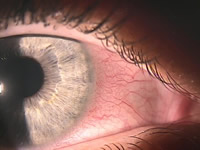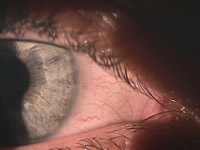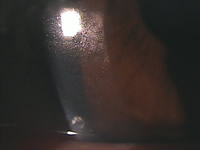Silicone hydrogel lenses are now my lens material of choice for both 2 weekly and monthly disposable contact lens fits. The clinical success experienced with 30N CW use of silicone hydrogels (Focus Night & Day™, Purevison™) over the last 6 years has created an equally high performance expectation for more recent lens designs aimed at 6N, flexiwear or DW schedules. The high oxygen transmissibility, added lubricity and lower modulus of elasticity of the new generation silicone hydrogel polymers result in greater biocompatibility with the human eye in terms of insignificant hypoxic changes in the cornea over time, reduced hyperaemia, less sensitivity to air conditioning and low tear volume conditions plus greater overall comfort. The majority of my patients have long work days in low humidity air conditioned offices. When the benefits of new generation lenses are explained, my patients quickly appreciate the potential for increased comfort, lifestyle convenience and the prophylactic value offered by these lenses. None of them want to lose tolerance to contact lens wear in the future!
The O2Optix™, Acuvue Advance™, Oasys™ and now the new generation of Biofinity silicone hydrogel designs offer a more affordable and often more comfortable lens option for DW than the earlier highest Dk/l and stiffer 30N approved polymers. This makes new generation lenses popular with both practitioners and patients. I have found that some patients who were uncomfortable with Focus Night & Day™ 8.6 or Purevision™ have succeeded with O2Optix™ , Oasys™ or Acuvue Advance™ presumably due to the lower modulus of elasticity resulting in more contour conforming edge fits. However my steep cornea patients are usually still limited to the choice of the two steeper BC lenses of Acuvue Advance™ 8.3 or Oasys™ 8.4 to achieve best comfort.
Silicone hydrogel lenses have rehabilitated a large percentage of my contact lens patients who struggle to maintain wear time due to dry eye symptoms (including myself) and this I attribute to the added lubricity of the new generation polymer surfaces and the low water content demand of the materials. Here are two memorable case histories from my patient files:
One patient (CH aged 38) a -3.00D myope with corneal curvature of 7.65mm had successfully worn soft lenses for the first 15 years but gradually developed bilateral red eyes, but with no discomfort or corneal staining. After 3 years of subsequent daily disposable use she also developed dryness that curtailed her lens wear to 4 hours per day. To test the effect of hypoxia and the known benefit of reduced hyperaemia with silicone hydrogels, I fitted her with 8.3 Acuvue Advance™. After 2 months her bulbar redness had not abated and as her comfortable wearing time was still limited to 5-6 hours she had discontinued wear. After pre-conditioning the front surface ocular membranes with Bion Tears 4x day for two weeks she was refitted with Oasys™. She reported a daily 10-12 hours comfortable wear time at her 2 week aftercare and reduced redness.
She could survive a day in air conditioning at work now without lubricants but “tries to remember” to use her BionTears at least once per day!
 |
 |
Figure 1 |
Figure 2 |
click to enlarge |
click to enlarge |
Another patient (DC aged 34) has an emmetropic right eye and -2.50D myopic left eye with an 8.10mm corneal curvature and she was eager to try the convenience of CW with Focus N&D™ 8.6. After 3 nights CW her left eye was reportedly dry and scratchy during the day. Biomicroscopy showed severe front surface lipid deposit and mild back surface debris but no significant limbal redness.
 |
Figure 3 |
click to enlarge |
To test the effect on surface deposition, DC’s left eye was refitted with O2Optix™ to again attempt 3N CW. At the 1 week aftercare she was asymptomatic and biomicroscopy showed no significant front surface tear deposit. She continues to comfortably wear the lens on a 5N CW schedule for the last 6 weeks. I speculate that the lower modulus of the O2Optix™ material, giving more flexibility to the lens edge fit, may have irritated the tarsal conjunctiva less, thereby resulting in less surface deposition and greater comfort.
Personally, using a 30N schedule of +1.50D 8.6 BC Focus N&D™ for the last 4 years gives me the most comfortable experience working in air conditioning all day. The fit and moisture retention of this lens design on my low tear volume eye performs better than the examples I have tried of the new generation lower modulus lenses.
Over the last year I have learned that each silicone hydrogel lens design available has its own fan club of wearers and I endeavour to understand and develop a typical profile of characteristics of patients who prefer a specific lens type. This should refine my patient selection criteria for each silicone lens design available.
I find that if patients are totally comfortable with their lens wear – especially from the first fitting - they tend to be more loyal to the practice, a great source of patient referral and far less tempted to pursue the perceived benefits of refractive surgery.
|